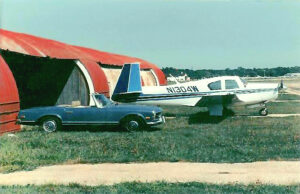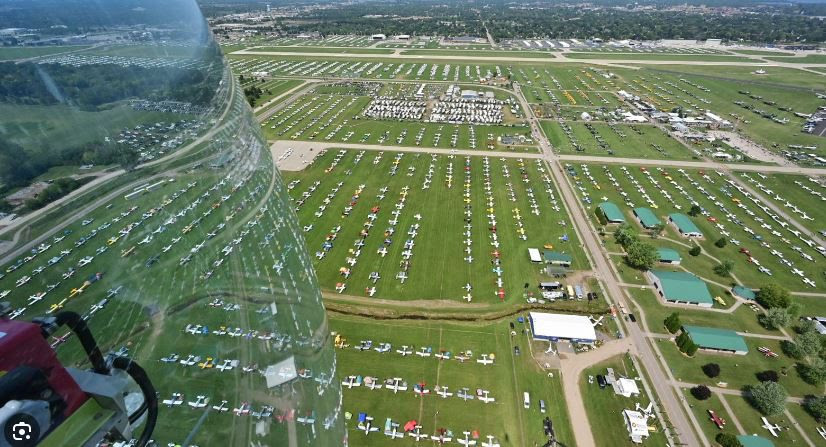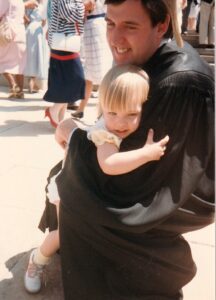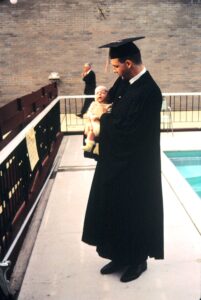1986-1987
As anyone who has observed a newly minted teenage driver’s first few years on the road (or those who can honestly remember their own), earning the license is when the real learning begins.
My experience as a pilot was no different. In my rush to attain a bunch of ratings (Private, Instrument, Commercial, Instructor, and Multi-engine), I hadn’t taken the time to practice the newly learned skills.
Settling in
The Mooney felt like an old friend. I was looking forward to flying everywhere and in nearly any conditions; day or night, winter or summer, clear skies or cloudy with low ceiling.

When I returned to Palwaukee from purchasing it in Florida, I had a wonderful surprise. I had envisioned spending the next few winters shoveling snow from around the plane then sweeping it off the wings whenever I wanted to fly. The wait list for a T-hangar at Palwaukee was rumored to be measured in years. This for a 40-year-old quonset hut with a door that rattled over the top of your plane leaving rust crumbs all over the wings every time you opened or closed it. So when I walked into Priester’s office and Tim, the line manager, said one had just opened up – I couldn’t believe my ears.
First adventure – EAA Airventure
One of my first flights was to join a crowd of 650,000 heading to the EAA Airventure in Oshkosh, where for one week every year it becomes the world’s busiest airport. Every imaginable aircraft from experimental homebuilts to Mach 2.0 fighter jets and C-5 mega transports would be there.

Flying into Oshkosh is amazing. Imagine the traffic at a Cubs or Bears game. Unlike cars, however, planes have to keep moving at 90 mph or more to stay in the air. Well ahead of time, pilots study the 30-page NOTAM detailing the procedures required to approach the airport.
Traffic in managed by the best air traffic controllers in the country. About a dozen of them stand on the back of a flatbed truck with binoculars, scouring the sky for inbound planes. One controller is on the radio talking non-stop to pilots: “Yellow high-wing, follow the blue Bonanza and rock your wings,” etc. Unlike in normal airport operations, pilots remain silent. They just listen and follow directions. Beautifully simple and busy … and with a nearly perfect safety record for 70 years.
A friend and I would fly in in the morning, wander around the exhibits until the airshow, then join the mass exodus when the final demonstration comes to rest. That was the plan. And the day was wonderful … even the preflight inspection prior to the trip home was smooth. But when I turned the ignition key, the silence was deafening.
Buying the Mooney was only my second experience in used airplanes. The first, the Baron, was from a man I had known and trusted for nearly twenty years – and the plane was nearly flawless. The second, this Mooney, was from a complete stranger in Florida. When he demonstrated it, the engine started like magic. By the time I got home, his magic was long gone.
A few weeks later, considerably poorer and somewhat wiser, the Mooney was restored to the condition I thought I had paid for.
Business trip and yet another lesson

In the spring of 1987, we learned the publisher of Decorative Arts Digest (renamed to Painting Magazine) was interested in selling. She lived in Kissimmee, Florida right around the corner from my parents in Orlando. Off I flew. In a couple days we were able to complete a deal, and I was ready to pack her minimal office equipment in the back of my Mooney station wagon and head home.
An important pre-flight planning step is to compute the weight and balance (w&b) of the plane and its contents. I always tell students that too much weight makes the plane sluggish; out of balance makes it uncontrollable. While neither is acceptable, the latter will kill you.
By this time I had accumulated just enough experience to become complacent. I knew the airplane well; the stuff that I was putting into it didn’t amount to much; and there was only a limited amount of space to put it – I didn’t need to compute weight and balance – I’d done it dozens of times.

So I threw everything in the back and got ready to go. As I was taxiing to the runway, the nose seemed to float up a bit – almost off the ground. One thing I had learned: Never knowingly take a problem into the air. I stopped and took a closer look at my load. I was clearly not too heavy. There was only me in the front seats, nothing in the back seats, office equipment in the luggage area behind the seats, AND two large bags of oranges on the hat rack behind the luggage area. I wasn’t overweight, but the center of gravity was way too far back. I was likely to have control issues. Maybe fatal.
Pros don’t take shortcuts and I aspired to become a pro. When I got home, I computed w&b for a half-dozen frequently used configurations that I might use in the future. In the rare case that my load was not in the list, I promised myself that I would take the extra five minutes to compute it.
Impromptu location shoot

One of my jobs as publisher of Crafts ‘n Things Magazine was staff photographer. That spring I was sitting in on a photo planning meeting where the art director described the focus of the issue as southwest crafts. As we looked at several dozen projects, she described the different desert-like setting that would be appropriate for each one, and where she could find the materials to create it.
It didn’t take but a minute for me to realize this was a natural opportunity for a location shoot. Let’s pack the samples into the back of my Mooney, fly out to Albuquerque, and shoot against real southwest beauty.
This would be my longest trip yet – more than a thousand nautical miles (1,200 statute miles). Still, at 150 knots (173 mph) that’s only about seven hours plus a fuel stop. That’s seven hours if there’s no wind. When I called for weather, the briefer gave me the bad news: 45 knot winds would be right on my nose. My ground speed would be only 105 knots – adding hours to my flight.
At least on the return trip two days later, I could enjoy having the wind at my back. I called FSS again. The wind had done a 180. It was still 45 knots, but it was right on my nose AGAIN. That’s just wrong!
We did have a great shoot and the magazine looked sensational. As a bonus, I visited Old Town Albuquerque and found a necklace and earrings for Marie with dozens of beautiful hand carved fetishes.
A special occasion


Also that spring, my son Scott graduated from Drake University in Des Moines. When I flew out for the ceremony with a couple of our kids, I realized my hope of never driving six hours when I could fly less than two. The kids were especially thrilled when we were directed to park right next to Jon Bon Jovi’s Gulfstream.
A special part of the celebration was Scott’s hugging his baby sister Annie while wearing his cap and gown … much like I held Scott in my arms at my graduation 23 years prior.
Updating the Mooney
By summer, getting in the Mooney was like putting on a pair of well worn sandals. But like the sandals, its age was showing. Especially the antiquated scratchy radios. I didn’t want to put all new radios in an airplane that was already 20 years old, but Joliet Avionics (now J.A. Air Center) had just the right combination of newer equipment at a modest price. My Mooney became a dream plane for even more flying.
More to come…
Total flying time to date: 813 hours
New types: None
New ratings: None
